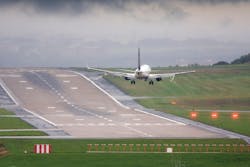Optimizing Aviation Efficiency and Safety When Severe Weather Strikes
When you’re responsible for ensuring safe and efficient takeoffs and landings, inclement weather is not your friend. From thunderstorms and snowstorms to heavy winds, rain, fog and ice, severe weather events can create potentially hazardous conditions that cause cost-prohibitive, inconvenient delays and put lives at risk.
Whether developing suddenly or slowly, inclement conditions are, according to the Federal Aviation Administration, by far, the largest cause of flight delays. In fact, inclement weather causes nearly 70 percent of all flight delays of greater than 15 minutes in an average year. Worse yet, while human error is the most common cause of accidents, weather is a primary contributing factor in nearly 25 percent of all aviation accidents, with a National Transportation Safety Board study revealing more than two-thirds of all weather-related general aviation crashes have been fatal.
No matter where in the world an airport is located, severe weather conditions can complicate how air traffic controllers, pilots and airport personnel decide to maintain the safety and efficiency of airport operations.
How Severe Weather Impacts Daily Operations and Personal Safety
Given the busy nature of airports, efficient daily operations are essential while ensuring travelers fly safely to their destinations. Understandably, at airports of all sizes across the globe, severe weather can have a dramatic impact on both these factors. Let’s take a look at some of the most common severe weather phenomena affecting aviation.
Lightning
Lightning strikes can cause serious injuries and even death to fliers and airport/airline personnel, damage aircraft, interfere with avionics, shut down engines and even incapacitate pilots.
Complicating the issue, many airports don’t effectively monitor lightning or mitigate its impact. Some smaller airports use audible thunder to indicate the presence of lightning in the area, while most others employ basic single-point sensors that are challenged to communicate a storm’s precise location or classify in-cloud versus cloud-to-ground strikes. Beyond uncertain lightning information, disparate safety procedures and warning criteria hamstring airport operations because notifications alerting personnel when to halt operations and move to shelter, as well as when it is safe to resume, can be inconsistent.
Wind Shear
Wind shear — or the sudden change in the direction or velocity of wind — most commonly impacts aviation in the form of delays, cancellations and diversion of flights to alternative airports, but it can also quickly create dangerous situations during takeoff and landing.
Whether landing or taking off, large commercial aircraft must be able to avoid drastic disruptions to their flight paths caused by one of the most dangerous — and difficult to assess — weather phenomena in aviation. Even though winds alone are rarely the cause of accidents, wind shear remains a persistent risk because it takes place at a height, and under flying conditions, when planes are most vulnerable.
Since wind shear puts lives at risk and can lead to crippling financial damages, airports need to reliably perceive wind shear dangers, alert the appropriate personnel and take action before accidents happen.
Low Visibility
Every year, low visibility cancels, delays or disrupts flights around the world. Whether the product of water (rain, fog, snow, sleet, graupel) or rock-based obscurants (sand, dust or other particulate matter), visibility is an important factor in all phases of flight. Good visibility means airports can maximize inbound/outbound aircraft so that they are running at full capacity. However, as visibility decreases, airport operations have to become less efficient to ensure safe departures and arrivals.
Freezing Conditions
When temperatures plummet and precipitation falls from the sky, freezing conditions complicate daily operations and require extra time and manpower to ensure safe travel. In addition to causing costly delays and cancellations, extreme cold forces decision-makers to deice and anti-ice aircraft, as well as ameliorate the impact of freezing conditions on runways and taxiways. Unfortunately, the deicing and anti-icing processes create significant time and cost impacts. Not only are the fluids used costly, but queuing planes for deicing only further delays operations.
While aviation decision-makers cannot control Mother Nature, there is a broad range of tools available to help mitigate the impact of lightning, wind, fog, icing and other dangerous weather conditions to make aviation safer and more efficient.
Mitigating Risk and Improving Safety with Measurement Technologies
When it comes to severe weather, balancing minimal operational downtime with optimal safety can be difficult without the right tools. To ensure safe and efficient airport operations in all weather, decision-makers need accurate assessments of wind, visibility, cloud height, pressure, lightning, wind shear, precipitation, runway surface conditions and more. That’s where aviation weather management systems that incorporate a wide range of sensors to produce real-time reports and alerts come in.
Measuring lightning involves standalone sensors that detect nearby lightning, a precision lightning network that includes more advanced sensors deployed around the airport and a global lightning network able to detect all lightning events around the globe. Combined, these components can be integrated into systems to trigger lightning warnings that keep staff and passengers safe while ensuring operations run at optimal efficiency.
For wind shear, the best aviation weather management systems incorporate three measurement technologies: a low-level wind shear alert system (LLWAS), weather radar and scanning wind lidar. LLWAS measures average wind speed and direction using a network of remote ultrasonic sensors fixed around runways and along approach or departure corridors. Weather radar, used during precipitation, can measure the wind field from the entire aerodrome and beyond. Scanning wind lidar, used in clear sky conditions, provides wind shear detection, 3D wind information and wind inversion detection that can measure the entire field, from the runway and its approach and take-off areas.
Concerning visibility, categorized airports must have instrumented meteorological optical range (MOR) measurements and a system calculating Runway Visual Range (RVR), the most essential factor for enabling air traffic control and pilots to make the correct operational decisions. Visibility, or MOR, can be measured with two approved technologies: transmissometer and forward scatter, with transmissometer technology like Vaisala’s LT31 transmissometer. Forward scatter technology, such as Vaisala’s FD70, is, in addition to the meteorological visibility (MOR), able to measure the drop size distribution and velocity of falling hydrometeors as well as offer present weather detection.
Weather radars can deliver precise meteorological information for a specific area, tracking the location of severe storms. By providing advanced warning of a broad range of approaching weather phenomena, including wind shear, precipitation type and amount, thunderstorms, microbursts and more, weather radar can enable good situational awareness and help improve safety and airport efficiency.
Additionally, novel lidar ceilometers can detect freezing conditions in the atmosphere at altitude. With these measurements, decision-makers are able to notify any planes flying through how they could be impacted and enable airport operators to monitor potential nearby snowfall, which will lower RVR, force runway maintenance teams to clear runways and taxiways, cause flight delays and lower the frequency of takeoffs and landings.
When airports are selecting the technologies comprising their aviation weather management system, it is important to consider vendors that offer comprehensive solutions that integrate individual sensors, sensor suites and complex systems to provide situational awareness. Vendors should also be experienced in aviation so that they have insight into what airports face when it comes to the impact of severe weather on operations and safety.
To maintain scheduled operations and keep staff and travelers safe, decision-makers require precise and timely weather information to plan ahead, rapidly react to changing conditions and reduce disruptive delays. With the right technologies, airport decision-makers can measure and detect severe weather and take the proactive steps necessary to minimize delays and cancellations, while keeping operations running as safely and smoothly as possible.
Timo Lindfors is a 20-year employee of Vaisala with a background in the company’s research and development projects on dropsondes, sounding systems, services development and aviation systems. As part of Vaisala’s aviation team, Lindfors has been involved with numerous wind shear projects with customers worldwide to review and plan how to implement the best fit-for-use wind shear systems.
About the Author

Timo Lindfors
Application Manager
Timo Lindfors is a 20-year employee of Vaisala with a background in the company’s research and development projects on dropsondes, sounding systems, services development and aviation systems. As part of Vaisala’s aviation team, Lindfors has been involved with numerous wind shear projects with customers worldwide to review and plan how to implement the best fit-for-use wind shear systems.
